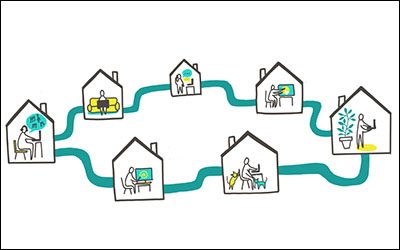The pandemic may have removed the greatest barrier to adopting online collaboration. Now you have no alternative and are absolutely required to do it. Once you find yourself collaborating online, however, what are the best things to do?
This article is based on my experience with online collaboration since 1981. Lately, I’ve been a Teams user, so this will assume a conferencing system with Teams-like features. CGNET is a small company, so this will be about collaboration with small groups. Finally, the people in most of the groups I’m in are professionals, with the rights and privileges pertaining thereunto.
Rule One: It Depends
Every tip here will not apply in some situation. As they say in design school, start with empathy. Figure out what each person will need. Be able to revise your opinions if you get better information. Customize things to the group.
Leadership
One thing I’m sure about is that every collaboration group needs a leader. This is not an exalted leader, but you need somebody to keep the group’s mission and schedule and to help people participate. It’s basically an issue of coordination, with just enough authority to coordinate effectively.
A second aspect of leadership matters during a live meeting. Studies at the University of Wisconsin-Extension have shown that after about 10 minutes of listening, participants’ attention wanes. The trick is to ask each of them something. Talking wakes them back up.
Scope
One of the reasons that most of CGNET’s collaborations are easy is that they are focused on doing a well-defined project for a specific client. This provides a clear purpose and schedule. It also defines who needs to participate.
If I’m setting up a different group, I try to define the same things: a project with clear borders and milestones, plus clearly defined roles. If these are not externally determined, as they are when we have a contract, defining them becomes the first order of business. I would never establish a group called, “Getting to Know Teams.” That invites a trip down the rabbit hole.
Socializing
A little bit of warmth or fun is good, but it’s easy to do too much. Participating in an online collaboration is a like playing in a band. An occasional quick improvised riff may work, but too much can make the number as a whole fall apart. This is especially true when one comment follows another in posts where important posts can get lost among chatter. Remember that the ongoing conversation is a reference work as well as a real-time experience.
Size
Back in graduate school, I read that the ideal size for a meeting was “the magic number seven, plus or minus three.” For meeting online, however, I’ve found that the fewer participants you have, the better. Every time you add somebody, you have another schedule to accommodate and another person to keep active, either in real time or over time. If a person’s presence is necessary to the project, however, include them.
Schedule
Schedules are essential. Write them down and post them as files. We use Microsoft Project, but this is hard to learn. Even a task list in Excel is better than nothing. Keep to the schedule if you can. If you can’t, keep the schedule updated.
You may be having a combination of real-time meetings and work file-sharing and posting in-between. If so, reviewing the project with the schedule is a great way to start a live meeting.
Scheduling meetings is an important part of the overall schedule. Do it in advance for the whole project and revise as necessary. Get it on people’s calendars.
Deadlines
I love deadlines. I love to assign them, and I love to have them assigned to me. They can be negotiated at the outset, so they seem less like orders. Also, I lie about deadlines I assign. I try to build some time between the deadline and when the work is really needed. People underestimate the amount of time they will need for a project all the time. Plan for this.
It’s possible to integrate Microsoft Planner with Teams and use it to post a schedule. This may work. I generally prefer, however, to simply put promises in Posts for when tasks will be done and for the leader to follow up on that as necessary.
Simplicity
In a good collaboration, the process doesn’t get in the way. So, don’t try to learn a new application in order to collaborate. Obviously, if you have no app at all, you will have to learn one. Here’s a nice beginner’s primer for Teams. But try not to decide midstream that you would rather use a project management app, for example.
Try to make things work with the minimum of features. For example, in Teams you can set up a Wiki for each group. I’ve never done it. For me posts, files and chat are plenty. Of course, for real-time communications, use audio and/or video.
Simplicity also applies to what you say. Brevity is the soul of wit. Like email, posts are an imperfect medium. It is better to be clear than to be clever.
Trepidations
I have the nagging feeling that I’ve forgotten something important. If you know what it is, please post a reply.





0 Comments